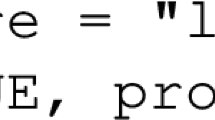Abstract
The comparison of partitions is a central topic in clustering, as well as when comparing partitioning algorithms or when classifying nominal variables. In this paper, we deal with the transfer distance between partitions, defined as the minimum number of transfers of one element from its class to another (possibly empty) necessary to turn one partition into the other one. After reviewing some theoretical results about this distance, we analyse its behaviour by an experimental study in order to make its interpretation easier.
Similar content being viewed by others
References
Barthélemy J-P (1979) Propriétés métriques des ensembles ordonnés. Comparaison et agrégation des relations binaires. PhD thesis, Université de Franche-Comté, Besançon
Batagelj V, Mrvar M, Zaversnik M (1999) Partitioning approach to visualisation of large graphs. In: GD’99 Proceedings of the 7th international symposium on graph drawing, Lecture notes in computer science, vol 1731. Springer, Berlin, pp 90–97
Boorman SA, Olivier DC (1973) Metrics on spaces of finite trees. J Math Psychol 10: 26–59
Charon I, Denœud L, Guénoche A, Hudry O (2006) Maximum transfer distance between partitions. J Classif 23(1): 103–121
Charon I, Denœud L, Hudry O (2007) Maximum de la distance de transfert à une partition donnée. Mathématiques et Sciences Humaines 179: 45–83
Day W (1981) The complexity of computing metric distances between partitions. Math Soc Sci 1: 269–287
de Frayssex H, Kuntz P (1992) Pagination of large scale networks; embedding a graph in \({\mathbb{R}^n}\) for effective partitioning. Algorithmic Rev 2(3): 105–112
Denœud L (2006) Étude de la distance de transfert entre partitions et recherche de zones denses dans un graphe. PhD thesis, Université Paris 1, France
Guénoche A (2005) Comparing recent methods in graph partitioning. Electron Notes Discrete Math 22: 83–89
Hubert L, Arabie P (1985) Comparing partitions. J Classif 2: 193–218
Jaccard P (1908) Nouvelle recherche sur la distribution florale. Bulletin de la Société Vaudoise des Sciences Naturelles 44: 223–270
Kuhn HW (1955) The Hungarian method for the assignment problem. Naval Res Logist Q 2: 83–97
Lerman IC (1988) Comparing partitions. Mathematical and statistical aspects. In: Bock HH (eds) Classification and related methods of data analysis, Elsevier, Amsterdam, pp 121–132
Lovász L, Plummer MD (1986) Matching theory. Annals of discrete mathematics 29, North-Holland
Matsuda H, Ishihara T, Hashimoto A (1999) Classifying molecular sequences using a linkage graph with their pairwise similarities. Theor Comput Sci 210: 305–325
Newman MEJ (2001) The structure of scientific collaboration networks. Proc Natl Acad Sci USA 98: 404–409
Nijenhuis A, Wilf H (1978) Combinatorial algorithms. Academic Press, New York
Rand WM (1971) Objective criteria for the evaluation of clustering methods. J Am Stat Assoc 66: 846–850
Régnier S (1965) Quelques aspects mathématiques des problèmes de classification automatique. ICC Bull 4
Rota G-C (1964) The number of partitions of a set. Am Math Mon 71(5): 498–504
Tijms H (2004) Understanding probability: chance rules in everyday life. Cambridge University Press, Cambridge
Wallace DL (1983) Comment. J Am Stat Assoc 78: 569–579
Youness G, Saporta G (2004) Une méthodologie pour la comparaison des partitions. Revue de Statistique Appliquée 52(1): 97–120
Author information
Authors and Affiliations
Corresponding author
Rights and permissions
About this article
Cite this article
Denœud, L. Transfer distance between partitions. Adv Data Anal Classif 2, 279–294 (2008). https://doi.org/10.1007/s11634-008-0029-0
Received:
Revised:
Accepted:
Published:
Issue Date:
DOI: https://doi.org/10.1007/s11634-008-0029-0




